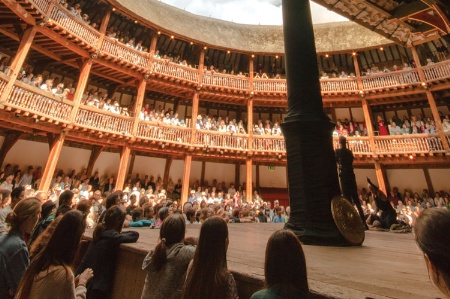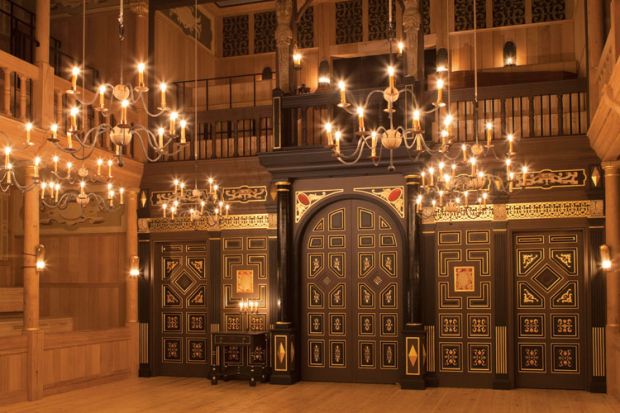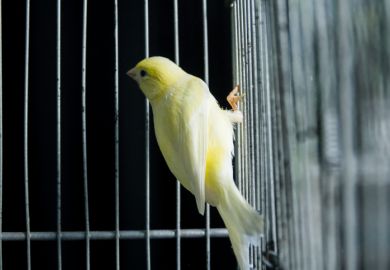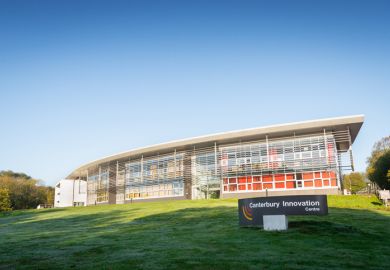Source: Pete Le May
Study spaces: Sam Wanamaker Playhouse, a replica of an early 17th century indoor performance space, is part of Shakespeare’s Globe
How were lighting, music and cosmetics used in the indoor theatres of Shakespeare’s day? Could big battle scenes work on a small stage? How much, and how uneasily, did audiences laugh at some of the tragedies?
Scholars have been asking such questions for decades. Although we may never have definitive answers, research at London’s Globe Theatre is providing important new approaches and insights.
The Sam Wanamaker Playhouse, an indoor, candle-lit theatre designed to replicate the indoor playhouses of the early 17th century, has been open for nearly a year now.
For Patrick Spottiswoode, director of Globe Education, the venue is a crucial additional research tool. The insights gained from putting on plays and testing scenes there have proved to be “as shocking and as revelatory” as those gained from doing productions in the main open-air Globe, a reconstruction of a theatre originally opened in 1599.
Along with public performances, the new site has been used for “a kind of academic tracking project called the Indoor Performance Practice Project”, said Will Tosh, a postdoctoral research fellow with Globe Education.
This has several strands. Dr Tosh makes detailed observations of the commercial productions. He solicits the responses of selected audience members. He interviews actors, directors and other members of the creative team about their staging and performance decisions. And he also runs Research in Action workshops to examine crucial questions that arise in performance.
There has, of course, been much written about Elizabethan and Jacobean “playhouse practice”, but this is “quite a conjectural field”, Dr Tosh said, relying on “very subtle information gleaned from playhouse texts and about two eyewitness accounts”.
The Sam Wanamaker Playhouse is broadly similar to the Blackfriars Theatre, where Shakespeare and the King’s Men performed from around 1609. This means that the most effective uses of “asides”, cosmetics, lighting, music and the recessed area behind the back wall known as the “discovery space” can be tested.
Each workshop, or “experiment”, focuses on one topic and requires actors to perform several scenes in different ways. Audiences of about 40 or 50, whose members range from scholars to private enthusiasts, give feedback on what they saw and felt.
What kinds of hypotheses can be explored? Scholars have often argued that the move to smaller theatres helped to put an end to “drum and trumpet” plays featuring huge battle scenes, in favour of more domestic dramas with quieter music.
So do such big history plays inevitably overwhelm a tiny Jacobean-style theatre?
“We have looked at bringing some of that brashness into the playhouse,” Dr Tosh said, “and it’s rather thrilling. There’s no real reason why you can’t have drums and trumpets, particularly behind or under the stage, because the entire space is made of wood and forms a kind of resonating chamber. There are much more creative musical possibilities than we might have thought.”

One workshop looked at the use of candles by staging scenes from three plays that seem to require special lighting effects. What it revealed, Dr Tosh said, was that winching up the candles can have a highly dramatic impact. “Particularly if you use pearlescent cosmetics, you just see the light drain from people’s faces,” he said. “If you’re sitting in the lower gallery or the pit, it’s like the hand of death has come over the actors.”
Another workshop explored the use of the “discovery space” through the final scene of The Winter’s Tale, in which the statue of Hermione comes to life. In the open air, this can require a good deal of suspension of disbelief on the audience’s part, stated Dr Tosh, because “everyone’s saying, ‘Behold this astonishing statue!’” even though the audience can see “her dress and hair flapping in the wind”. Indoors, by contrast, “lower light and stillness mean you can create a real sense of illusion”.
But this still leaves open the question of whether the scene works better if the statue is wheeled out on a trolley to the main stage or if she comes back to life in the discovery space, where some of the audience can see the reanimation and some can only follow the reactions of the other characters. When both options were tried successively, strong preferences were expressed on both sides.
The same workshop also threw light on the scenes in seldom-performed Elizabethan and Jacobean plays that mix horror, comedy and pathos in ways that make it very difficult to gauge the likely audience reaction from the text alone. In Nathaniel Richards’ Messalina, said Dr Tosh, “a lascivious queen is trying to tempt her upright intended into bed. When he says, ‘I’m not that kind of guy’, she drags him off, puts him on a rack and tortures him until he agrees to have sex with her.” Once when they put it on stage, with the racking taking place in the discovery space at the back, the audience all burst out laughing (although this may have been partly because his twitching legs were poking out).
Dr Tosh is fascinated by the “challenging intimacy” of the space and is impressed by how “language-hospitable” it has proved. In the scenes dealing with brother-sister incest in John Ford’s ’Tis Pity She’s a Whore, for example, audiences have been “very taken aback to hear every word, though even scholarly theatregoers are used to missing a lot of the verbal detail”.
Full sensory scholarship
However carefully captured and stimulating, the reactions of today’s audiences can never tell us directly what Shakespeare’s contemporaries may have felt or how a particular play or scene ought to be staged.
Yet they do suggest, in Dr Tosh’s view, that people respond “in a complex and multi-layered way” to Renaissance dramas in authentic settings depending, among many other factors, on where they are sitting. That means the Research in Action workshops should help to take forward “an emerging trend in theatre scholarship that explores theatre as a multi-sensory experience and sees people’s responses to Elizabethan and Jacobean theatre as very rich, a sort of index of emerging modernity”.
Register to continue
Why register?
- Registration is free and only takes a moment
- Once registered, you can read 3 articles a month
- Sign up for our newsletter
Subscribe
Or subscribe for unlimited access to:
- Unlimited access to news, views, insights & reviews
- Digital editions
- Digital access to THE’s university and college rankings analysis
Already registered or a current subscriber? Login





